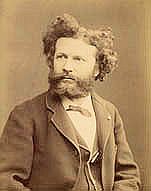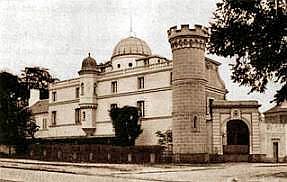Earliest Woodcut Source
NASA attributed the woodcut to the twentieth century. This bibliographic trivia raises the intriguing possibility that the original woodcut may not be authentic after all.
Yet the NASA caption again, like so many others, gives no specific source. How did the NASA writers know that it originated in 1911, without specifying a source?
Did they have one and not tell us? But how did they know the 1911 source was the first to use the woodcut? How can we know when we have found the "first" occurrence
of the woodcut?
As it turns out, the attribution to an unspecified 1911 source is demonstrably false, for the woodcut appears in black and white in
Camille Flammarion,
L′Atmosphere: Météorologie Populaire (Paris, 1888), p. 163. This book by the "Carl Sagan of the nineteenth-century" is held in the History of
Science Collections of the University of Oklahoma, from which the slide for this image was taken.
Flammarion (1842-1945) was an astronomer and a popular science writer.
For life, work, and writings: the excellent Flammarion website of the French Ministry of Culture.
 Original woodcut in Flammarion 1888 |
Flammarion′s picture is surrounded by a decorative border, which does not appear to be extrinsic to the woodcut but an original part of it. This border, a feature which
suggests the non-medieval origin of the picture, has been cropped out in many of the reprints. The woodcut is unsigned, like many but not all of the other illustrations in
Flammarion′s works. Its caption reads: "Un missionnaire du moyen age raconte qu′il avait trouvé le point où le ciel et la Terre se touchent..."
This appears to be a summary of the accompanying text, in which Flammarion introduces, with extremely colorful prose, the question: "What, then, is this blue [sky],
which certainly does exist, and which veils from us the stars during the day?"
The complete paragraph just prior to this question is:
 "Que le ciel soit pur ou couvert, il se présente toujours à nos yeux sous l′aspect d′une voûte surbaissée. Loin d′offrir la
forme d′une circonférence, il paraît étendu, aplati au-dessus de nos têtes, et semble se prolonger insensiblement en descendant peu à
peu jusqu′à l′horizon.
"Que le ciel soit pur ou couvert, il se présente toujours à nos yeux sous l′aspect d′une voûte surbaissée. Loin d′offrir la
forme d′une circonférence, il paraît étendu, aplati au-dessus de nos têtes, et semble se prolonger insensiblement en descendant peu à
peu jusqu′à l′horizon.
Les anciens avaient pris cette voûte bleue au sérieux. Mais, comme le dit Voltaire, c′était aussi
intelligent que si un ver à soie prenait sa coque pour les limites de l′univers.
Les astronomes grecs la représentaient comme formée
d′une substance cristalline solide, et jusqu′à Copernic un grand nombre d′astronomes l′ont considérée comme aussi
matérielle que du verre fondu et durci.
Les poètes latins placèrent sur cette voûte, au-dessus des planètes et des étoiles fixes,
les divinités de l′Olympe et l′élégante cour mythologique. Avant de savoir que la Terre est dans le ciel et que le ciel est partout, les
théologiens avaient installé dans l′empyrée la Trinité, le corps glorifié de Jesus, celui de la vierge Marie, les hiéarchies
angéliques, les saints et toute la milice céleste...
Un naïf missionnaire du moyen âge raconte même que, dans un de ses voyages à la
recherche du Paradis terrestre, il atteignit l′horizon où le ciel et la Terre se touchent, et qu′il trouva un certain point où ils
n′étaient pas soudés, où il passa en pliant les épaules sous le couvercle des cieux...
Or cette belle voûte n′existe pas!
Déjà je me suis élevé en ballon plus haut que l′Olympe grec, sans être jamais parvenu à toucher cette tente qui fuit à mesure
qu′on la poursuit, comme les pommes de Tantale."
In English Flammarion′s passage reads:
"Whether the sky be clear or cloudy, it always seems to us to have the shape of an elliptic arch; far from having the form of a circular arch, it always seems flattened
and depressed above our heads, and gradually to become farther removed toward the horizon.
Our ancestors imagined that this blue vault was really what the eye would lead them
to believe it to be; but, as Voltaire remarks, this is about as reasonable as if a silk-worm took his web for the limits of the universe.
The Greek astronomers represented it
as formed of a solid crystal substance; and so recently as Copernicus, a large number of astronomers thought it was as solid as plate-glass.
The Latin poets placed the
divinities of Olympus and the stately mythological court upon this vault, above the planets and the fixed stars. Previous to the knowledge that the Earth was moving in space,
and that space is everywhere, theologians had installed the Trinity in the empyrean, the angelic hierarchy, the saints, and all the heavenly host...
A missionary of the Middle Ages even tells us that, in one of his voyages in search of the terrestrial paradise, he reached the horizon where the earth and the heavens met,
and that he discovered a certain point where they were not joined together, and where, by stooping, he passed under the roof of the heavens...
And yet this vault has, in fact,
no real existence! I have myself risen higher in a balloon than the Greek Olympus was supposed to be situated, without being able to reach this limit, which, of course,
recedes in proportion as one travels in pursuit of it - like the apples of Tantalus."
Thus Flammarion uses the woodcut to propagandize for the flat earth myth, drawing on an anecdote that so far I have been able to trace only as far back as Voltaire.
There is a rumor that Flammarion′s diaries at the Juvissy Observatory,
where he worked, acknowledge that he had the woodcut made. At least, someone told me this at an international planetarium conference, saying he met a person who had seen them.
Unfortunately I have not been able to trace her name, so the trail seems to end here.
James Glaisher, of the Royal Observatory at Greenwich, edited a translation of the 1872 edition of L′Atmosphère into English in 1873, condensing
Flammarion′s excessive prose into a volume less than half as many pages long as the 824 page original. Glaisher explained that Flammarion, like other popular French
writers, displayed "a tendency to imaginative" writing inconsistent with "the precision and accuracy that ought to be characteristic of scientific information,
even when expressed in language free from technicalities."
Glaisher continued:
"There is a good deal of this exalted kind of composition in M. Flammarion′s book, which - even in the French not very agreeable to an English reader - becomes,
when translated, intolerable. I have, therefore, omitted these rhapsodies very freely, though traces enough of them will be found here and there to betray the French origin of
the work."
"The task of editing has not been a light one," Glaisher added, citing the obligation to correct various factual errors. Interestingly, although the New York edition
includes 10 color plates and 86 woodcuts, it does not contain the flat-earth representation.
A recent book, The Mathematical Experience, by Philip Davis and Reuben Hirsch, includes the woodcut along with the border and echoes the quest theme, its caption reading:
"The astronomer reaches for truth. He is depicted as breaking through the shell of appearances to arrive at an understanding of the fundamental mechanism that lies behind
appearances." They credit Flammarion without any suggestion of the flat earth myth.
Whether as a metaphor of the flat-earth, of the alleged flat-earth, of cosmological
thought experiments, or (especially) of the human quest to explore the unknown, this woodcut has proven to be an extremely durable piece of visual rhetoric.
